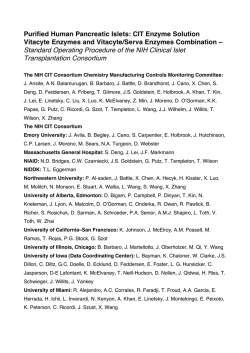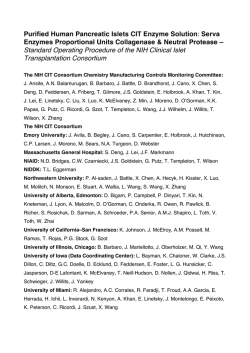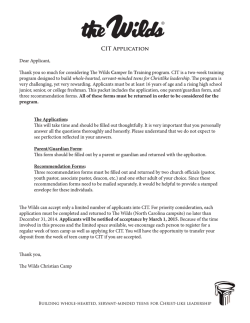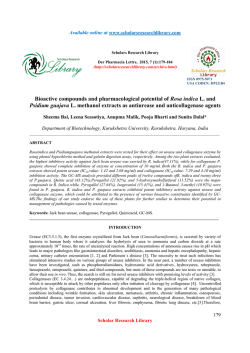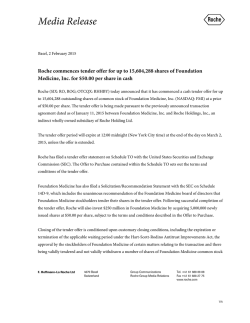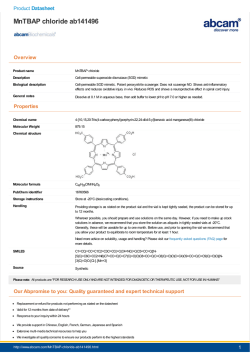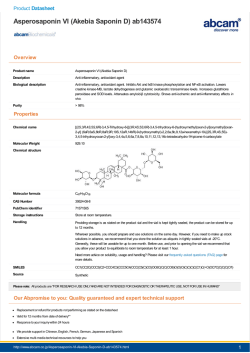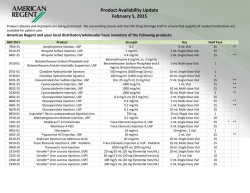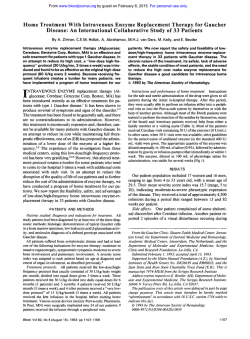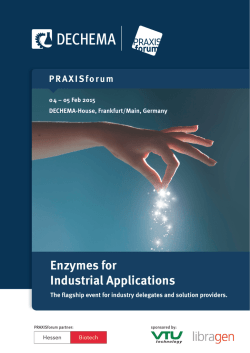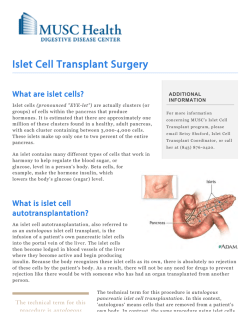
SOP 3106, B14 v01 Roche Enzymes Solutions, May 2, 2011
Purified Human Pancreatic Islets CIT Enzyme Solution Roche Enzymes – Standard Operating Procedure of the NIH Clinical Islet Transplantation Consortium The NIH CIT Consortium Chemistry Manufacturing Controls Monitoring Committee: J. Ansite, A.N. Balamurugan, B. Barbaro, J. Battle, D. Brandhorst, J. Cano, X. Chen, S. Deng, D. Feddersen, A. Friberg, T. Gilmore, J.S. Goldstein, E. Holbrook, A. Khan, T. Kin, J. Lei, E. Linetsky, C. Liu, X. Luo, K. McElvaney, Z. Min, J. Moreno, D. O’Gorman, K.K. Papas, G. Putz, C. Ricordi, G. Szot, T. Templeton, L. Wang, J.J. Wilhelm, J. Willits, T. Wilson, X. Zhang The NIH CIT Consortium Emory University: J. Avila, B. Begley, J. Cano, S. Carpentier, E. Holbrook, J. Hutchinson, C.P. Larsen, J. Moreno, M. Sears, N.A. Turgeon, D. Webster Massachusetts General Hospital: S. Deng, J. Lei, J.F. Markmann NIAID: N.D. Bridges, C.W. Czarniecki, J.S. Goldstein, G. Putz, T. Templeton, T. Wilson NIDDK: T.L. Eggerman Northwestern University: P. Al-saden, J. Battle, X. Chen, A. Hecyk, H. Kissler, X. Luo, M. Molitch, N. Monson, E. Stuart, A. Wallia, L. Wang, S. Wang, X. Zhang University of Alberta, Edmonton: D. Bigam, P. Campbell, P. Dinyari, T. Kin, N. Kneteman, J. Lyon, A. Malcolm, D. O’Gorman, C. Onderka, R. Owen, R. Pawlick, B. Richer, S. Rosichuk, D. Sarman, A. Schroeder, P.A. Senior, A.M.J. Shapiro, L. Toth, V. Toth, W. Zhai University of California–San Francisco: K. Johnson, J. McElroy, A.M. Posselt, M. Ramos, T. Rojas, P.G. Stock, G. Szot University of Illinois, Chicago: B. Barbaro, J. Martellotto, J. Oberholzer, M. Qi, Y. Wang University of Iowa (Data Coordinating Center): L. Bayman, K. Chaloner, W. Clarke, J.S. Dillon, C. Diltz, G.C. Doelle, D. Ecklund, D. Feddersen, E. Foster, L. G. Hunsicker, C. Jasperson, D-E Lafontant, K. McElvaney, T. Neill-Hudson, D. Nollen, J. Qidwai, H. Riss, T. Schwieger, J. Willits, J. Yankey University of Miami: R. Alejandro, A.C. Corrales, R. Faradji, T. Froud, A.A. Garcia, E. Herrada, H. Ichii, L. Inverardi, N. Kenyon, A. Khan, E. Linetsky, J. Montelongo, E. Peixoto, K. Peterson, C. Ricordi, J. Szust, X. Wang University of Minnesota: M.H. Abdulla, J. Ansite, A.N. Balamurugan, M.D. Bellin, M. Brandenburg, T. Gilmore, J. V. Harmon, B.J. Hering, R. Kandaswamy, G. Loganathan, K. Mueller, K.K. Papas, J. Pedersen, J.J. Wilhelm, J. Witson University of Pennsylvania: C. Dalton-Bakes, H. Fu, M. Kamoun, J. Kearns, Y. Li, C. Liu, E. Luning-Prak, Y. Luo, E. Markmann, Z. Min, A. Naji, M. Palanjian, M. Rickels, R. Shlansky-Goldberg, K. Vivek, A.S. Ziaie University of Wisconsin: L. Fernandez, D.B. Kaufman, L. Zitur Uppsala University: D. Brandhorst, A. Friberg, O. Korsgren Supported by grants from the National Institute of Allergy and Infectious Diseases and the National Institute for Diabetes and Digestive and Kidney Diseases. • At Emory University, U01AI089317. • At Northwestern University, U01AI089316. • At the University of Alberta, Edmonton: U01AI065191. • At the University of California, San Francisco, U01DK085531. • At the University of Illinois, Chicago, 5U01DK070431-10. • At the University of Iowa, U01DK070431. • At the University of Miami, U01DK070460. • At the University of Minnesota, U01AI065193. • At the University of Pennsylvania, U01DK070430. • At Uppsala University, U01AI065192. In addition, the study was supported by the following GCRC and CTSA awards: • At Emory University: UL1TR000454. • At Northwestern University: 5UL1RR025741 and 8UL1TR000150. • At the University of California, San Francisco, UL1TR000004. • At the University of Illinois, Chicago, UL1TR000050. • At the University of Miami: 1UL1TR000460. • At the University of Minnesota: 5M01-RR000400 and UL1TR000114. • At the University of Pennsylvania: UL1TR000003. Address correspondence to: Camillo Ricordi MD, Chairman, CIT Steering Committee, [email protected] To cite this article Purified Human Pancreatic Islets CIT Enzyme Solution Roche Enzymes – Standard Operating Procedure of the NIH Clinical Islet Transplantation Consortium CellR4 2015; 3 (1): e1360 DAIT, NIAID, NIH SOP ATTACHMENT Document No. Revision No. 3106, B14 01 Document Title: Effective Date 02 May 2011 Supersedes Date 28 October 2010 Page 1 of 5 PURIFIED HUMAN PANCREATIC ISLETS CIT ENZYME SOLUTION ROCHE ENZYMES Manufacturing Site: 1.0 Date: Materials: Material Source Expiration Date Lot # Hanks’ Balanced Salt Solution (HBSS) Heparin Sodium Injection USP, Preservative free _______Units/mL Quantity Required Quantity Used 500 or 1000 mL mL ________mL mL Quantity Required Quantity Used Note: Add 10u/ml of heparin in HBSS 1.1a Material Source Expiration Date Lot # Calcium Chloride USP (Dihydrate) (CaCl2 2H2O) 160 or 320 mg 1M HEPES (To dissolve CaCl2 2H2O) 12.8 or 25.6 mL mL Quantity Required Quantity Used mg OR 1.1b Material Source Lot # Calcium Chloride Injection USP (CaCl2), 10% Solution Expiration Date 1.6 or 3.2 mL Islets Lot Number: mL Document No. Revision No. Effective Date Supersedes Date Page 2 of 5 3106, B14 01 02 May 2011 28 October 2010 Document Title: PURIFIED HUMAN PANCREATIC ISLETS, CIT ENZYME SOLUTION, ROCHE ENZYMES 1.2 Enzyme solution Material Source Lot # Expiration Date HBSS with Heparin Quantity Required Quantity Used q.s. to 350 to 500 mL mL Sterile Water For Injection USP Liberase MTF C/T GMP Grade Collagenase Liberase MTF C/T GMP Grade Thermolysin 2.0 Roche 1 or 2 Containers Container(s) Roche 1 or 2 Containers Container(s) Procedure 2.1 Preparation of HBSS and Calcium Chloride solution 2.1.1 Prepare 500 or 1000 mL of HBSS with Heparin concentration of 10 U/ mL. 2.1.2 2.1.3 2.1.4 2.2 HBSS Volume: mL Heparin Volume: mL When using powder, add 160 mg (or 320 mg) of CaCl2 2H2O to a 50 mL conical tube. Add 12.8 mL (or 25.6 mL) of 1M HEPES to the 50 mL conical tube and mix to dissolve. Filter the Calcium Chloride solution through a 0.22 micron filter. OR When using Calcium Chloride Injection USP, 10% solution (13.6 meq/10 mL), add 1.6 mL (or 3.2 mL) at the time of enzyme preparation. Determine the weight of pancreas: Calculate the Estimated Final Trimmed Pancreas Weight (C) based on the Initial Trimmed Pancreas Weight (A) from PBR Section 5.7, and estimated cannulae, fat, blood vessel and connective tissue weight (B): A – B = C Initial Trimmed Pancreas Weight (g) (A) 2.3 Estimated cannulae, fat, blood vessel and connective tissue weight (g) (B) Estimated Final Trimmed Pancreas Weight (g) (C) Determine the volume of enzyme to be prepared: Estimated Final Trimmed Pancreas Weight (g) (C) <100 CIT Enzyme Solution Final Volume (mL) 350 100-125 400 126-150 450 >151* 500 * For a pancreas >150 g, there is an option to divide the pancreas into two portions and digest these separately Final volume of enzyme solution: _________________________mL Islets Lot Number: Document No. Revision No. Effective Date Supersedes Date Page 3 of 5 3106, B14 01 02 May 2011 28 October 2010 Document Title: PURIFIED HUMAN PANCREATIC ISLETS, CIT ENZYME SOLUTION, ROCHE ENZYMES 2.4 Determine a target collagenase quantity to be used according to characteristics of the donor and pancreas, and record the rationale in the comments section below. For most donor pancreata, 21 – 32 Wünsch units per gram Estimated Final Trimmed Pancreas Weight is desirable. For older donors or more fibrotic organs, this value may be increased by up to 50% at the discretion of the manufacturing team lead. Target Collagenase Concentration (D): Wünsch Units/g pancreas Comments: 2.4.1 Calculate the amount of collagenase needed (E): C X D = E Estimated Final Trimmed Pancreas Weight (g) (C) 2.4.2 2.4.3 Target Collagenase Concentration (Wünsch Units/g) (D) Collagenase needed (Wünsch Units) (E) In a BSC about 45 minutes before the start of perfusion, aseptically add 20 – 40 mL HBSS (prepared in Section 2.1 above) to each vial (1 or 2 based on Wünsch units calculated in Section 2.2.3 above) of Collagenase. Maintain at cold temperature (2 to 8ºC recommended) until completely dissolved. Occasionally, swirl gently and avoid creating air bubbles. Calculate the volume of Collagenase solution to use in order to have the Wünsch Units of Collagenase needed: 20 – 40 mL/vial X Collagenase Units needed = X mL of Collagenase solution to use Wünsch Units/vial mL/vial X__ (E) Units = mL of Collagenase solution to use Wünsch Units/vial 2.5 Transfer the dissolved enzyme to a sterile bottle containing 300 mL of cold (2 to 8oC recommended) HBSS (prepared in Section 2.1 above). 2.6 Determine a target Thermolysin concentration according to characteristics of the donor and pancreas, and record your rationale in the comments section below. For most donor pancreata, 600 to 2000 units per gram Estimated Final Trimmed Pancreas Weight is desirable. For younger donors, this value may be increased by up to 50% at the discretion of the manufacturing team lead. For ischemically damaged pancreata, this value may be decreased by up to 50% at the discretion of the manufacturing team lead. Target thermolysin concentration (F): Comments: Islets Lot Number: units/g pancreas Document No. Revision No. Effective Date Supersedes Date Page 4 of 5 3106, B14 01 02 May 2011 28 October 2010 Document Title: PURIFIED HUMAN PANCREATIC ISLETS, CIT ENZYME SOLUTION, ROCHE ENZYMES 2.7 Calculate the amount of Thermolysin needed (G): C X F = G Estimated Final Trimmed Pancreas Weight (g) (C) Target Thermolysin Concentration (Units/g) (F) Thermolysin needed (Units) (G) 2.8 Aseptically add 5-10 mL of Sterile Water for Injection USP to Thermolysin bottle (each 1or 2 bottles) based on units needed (G), calculated in Section 2.6.2 above) vial of Thermolysin. Maintain at cold (2 to 8oC recommended) temperature until completely dissolved. Occasionally, swirl gently and avoid creating air bubbles. 2.9 Calculate the volume of Thermolysin solution to use in order to have the units of Thermolysin oe Neutral Protease needed (G): 5 – 10mL/vial X Thermolysin Units needed = X mL Units/vial mL/vial X Units= Thermolysin solution to use OR Neutral Protease mL Thermolysin or Neutral Protease solution to use Units/vial 2.10 Add the Thermolysin (or Neutral Protease)solution to the bottle containing the Collagenase solution immediately before use and swirl gently to mix. Avoid creating air bubbles. 2.11 Label the bottle with: “CIT Enzyme Solution” mL” “Volume prepared “Store at 2ºC to 8ºC” Date and Time Prepared (mmddyyyy, 24 hour clock) Expiration Date and Time (one half hour after preparation) (mmddyyyy, 24 hour clock) Initials of the person who prepared the solution 2.12 After final pancreas trimming, determine the final enzyme units used per g of trimmed pancreas: Actual (not Estimated) Final Trimmed Pancreas Weight (PBR Section 6.3) (H): 2.12.1 Collagenase (Wünsch Units) / Final Trimmed Pancreas Weight (g): E/H = J Collagenase Used (Wünsch Units) (E) 2.12.2 g Final Trimmed Pancreas Weight (g) (H) Collagenase Units/g (Wünsch Units/g) (J) Thermolysin (Units) / Final Trimmed Pancreas Weight (g): G/H = K Thermolysin Used (Units) (G) Islets Lot Number: Final Trimmed Pancreas Weight (g) (H) Thermolysin Units/g (Units/g) (K) Document No. Revision No. Effective Date Supersedes Date Page 5 of 5 3106, B14 01 02 May 2011 28 October 2010 Document Title: PURIFIED HUMAN PANCREATIC ISLETS, CIT ENZYME SOLUTION, ROCHE ENZYMES 2.13 Based on the final enzyme calculations, the timing and temperature of pancreas digestion should be adjusted to maximize islet yield. For example, if the final enzyme units used per g of trimmed pancreas (J or K) exceeds the target (D or F), the temperature set-point during digestion or the length of pancreas digestion can be lowered to compensate. When large differences from the target exist (poor estimation of final trimmed pancreas weight), the digest should be carefully monitored to adjust these parameters and determine the optimal switch point. Briefly describe the rationale for any adjustments made to the timing or temperature of pancreas digestion. Comments: Prepared by: Date: Reviewed by: Date: Islets Lot Number:
© Copyright 2025
